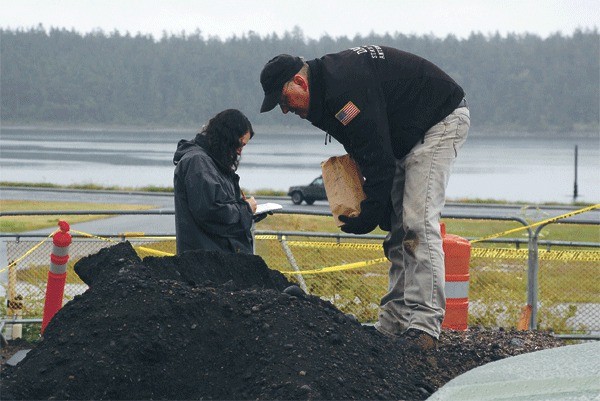Oak Harbor city officials were aware that the SE Pioneer Way Improvement Project was in close proximity to a known archeological site, but moved ahead anyway without adhering to the recommendations of state experts, according to the state Department of Archaeology and Historic Preservation.
Human remains were discovered early Thursday morning by a construction worker who was excavating a section of SE Pioneer in front of Mike’s Mini Mart. Additional remains were found at a location along Pit Road, which was being used as a dump site for dirt excavated from Pioneer Way.
Experts from the historic preservation office confirmed Saturday that the bones found are from at least three people and are Native American in origin.
But while city officials initially claimed surprise, saying they had no prior knowledge that a Native American site was in the project area, correspondence between the city and the historic preservation office indicate otherwise.
In a May 2009 letter to the city, Lance Wollwage, a transportation archaeologist with the Olympia-based agency, wrote that he had received project material sent by the city which confirmed Oak Harbor’s knowledge of an adjacent Native American site.
“As you described, the project area is in close proximity to a known archaeological site and we are concerned that you may encounter archaeological deposits during construction,” he wrote.
Wollwage went on to recommend that the city hire a professional archaeologist to monitor the construction work, develop a plan of how to address any artifacts or human remains that may be found, and consult with concerned tribes about cultural resource issues.
But none of that was done and Wollwage sent another letter to the city Monday questioning why their suggestions weren’t followed.
“Given your clear and advanced warning of the project’s archaeological hazards, we do not understand why our expertise and recommendations were ignored,” Wollwage wrote.
City Engineer Eric Johnston, who was at the excavation site most of Thursday morning, said the discovery was a big surprise. He claimed that Oak Harbor had done its due diligence by hiring an archaeological firm to evaluate the project area and that no indication of a Native American site had been found.
But, it now appears that the evaluation was never done, nor was any firm ever hired.
“I was mistaken,” Johnston said in an interview Tuesday morning.
A statement released Tuesday from the office of Mayor Jim Slowik said that the state’s recommendation to hire an archaeologist to monitor the project should have been followed. It also said Slowik planned to order a review of the city’s process to find out what happened, as the “city has a good record of following state requirements.”
“Once we review it, we can report back on what happened,” he said.
According to Allyson Brooks, director of the historic preservation office, while municipalities are required to consult the state office, city officials do not have to follow recommendations of the state experts. In this case, the city exercised its right to proceed with the project without adhering to their suggestions.
“We provided our expertise and I guess they didn’t take it,” she said.
However, the historic preservation office does have permit authority over archaeology sites and jurisdiction over non-forensic human skeletal remains. As the city is in the process of applying for an emergency permit application, Wollage warned in his letter Monday that the city should address several immediate issues.
Remains must be protected and respected until their final disposition is decided and all “ground-disturbing” activity must be monitored by a professional archaeologist, the letter states. If intact archaeological deposits are found, excavation in the area must stop until further evaluation can be completed.
The city did hire an archaeologist Thursday to monitor all remaining road excavation for the project and is keeping a close eye on both bone sites. Johnston could not estimate how much the archaeologist would cost but said that it’s one expense the city will just have to bear.
“I’m not sure what the cost will be but it’s going to have to happen,” he said.
Saturday’s examination also narrowed down the boundaries of the archeological site. Initially, nearly an entire block was cordoned off but the city was given the go-ahead to reduce the closure significantly and a lane of traffic was reopened at about 12:30 p.m. Saturday.
“That was a big relief,” Johnston said.
By closing down the whole block, the construction site was essentially split in half, which restricted work crews ability to move heavy equipment from one side of the project area to the other. Had the closure persisted, it would have severely impacted both efficiency and productivity, Johnston said.
As for the overall project schedule, it’s still too soon to know how or if it will be affected. Like everyone else, Johnston said the city will just have to wait to see what the tribes and the historic preservation office decide.



